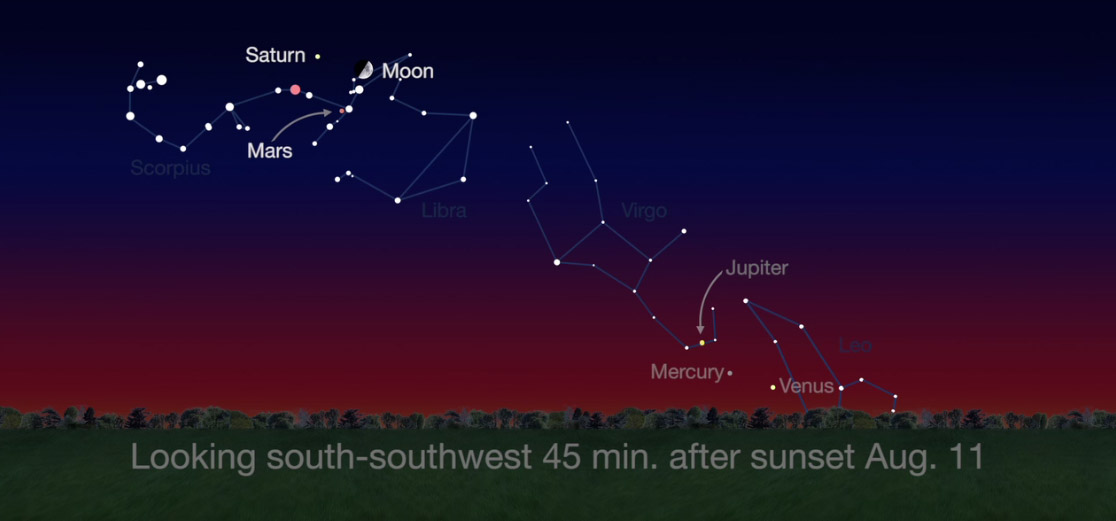See Mars, Saturn and Moon Align During Perseid Meteor Shower Tonight

Skywatchers in will be able to witness a celestial "summit meeting" this week as the moon, Mars and Saturn converge in the south-southwest evening sky.
It's a perfect illustration of what the late Kenneth L. Franklin, former chief astronomer at New York's Hayden Planetarium, called our "dynamic and ever-changing sky." Such an eloquent description will certainly fit the sky this week as darkness falls.
For the past few months, Mars and Saturn have been prominent in our evening sky. Now, as these two planets continue to recede slowly from Earth and consequently slowly diminish in brightness, they are joined on Thursday (Aug. 11) and Friday (Aug. 12) by our nearest neighbor in space, the moon. [Perseid Meteor Shower 2016: When, Where & How to See It]
On Thursday evening, many stargazers may be prepping for an all-nighter to watch for the peak of the Perseid meteor shower. (You can watch the Perseid meteor shower online via a free live webcast by the Slooh Community Observatory. The four-hour webcast begins at 8 p.m. EDT (0000 GMT). You can also watch the Perseids meteor shower webcast on Space.com, courtesy of Slooh.)
As the sun sets, sky viewers in the Northern Hemisphere will see, in the south-southwest sky, a large triangle formed by a waxing gibbous moonand the planets Mars (orange yellow, brightness magnitude minus 0.6) and Saturn (yellowish, magnitude 0.3). Skywatchers in the southern hemisphere will see this convergence higher up in the sky.
Saturn appears as a steady golden "star" when night begins. The most famous ringed planet shines 6.2 degrees above the red star Antares, the brightest star in the zodiacal constellation Scorpius, the scorpion. (Reminder: Your clenched fist held at arm's length measures about 10 degrees of the evening sky.) Saturn itself is in the large, dim constellation Ophiuchus, the serpent holder, where it will remain as it dives into the sun's glare in early November.
Two months have passed since Saturn's opposition, when Earth was between the ringed planet and the sun. Now, with the distance between our two worlds increasing, Saturn is gradually fading; it's now 897 million miles (1.44 billion kilometers) from Earth. Saturn continues to be a skywatcher favorite, as a telescope with as little as 30-power magnification will show the planet's magnificent ring system, currently tilted 26 degrees toward Earth.
Breaking space news, the latest updates on rocket launches, skywatching events and more!
Mars is much closer to Earth, at a distance of 73 million miles (117 million km). And even though it's still quite brilliant compared to Saturn and Antares, it has faded considerably since Memorial Day, when it made its closest approach to Earth in more than 10 years. In fact, it now appears more than 3.5 times fainter than it did back in late spring, and it will continue to fade as it moves away from Earth at an average rate of 501,000 miles (806,000 km) per day.
Of course, the moon appears to move most rapidly relative to the planets and background stars, as it's only 247,000 miles (397,000 km) from Earth. While it will form a triangular figure with the two planets on Thursday night, take note that on Friday night, the gibbous moon will have shifted enough to form a diagonal line with the moon in the upper left part of the sky, Mars on the lower right and Saturn in between.
Mars, moving faster than Saturn, will eventually pass Saturn and line up vertically with Antares in less than two weeks, making for another eye-catching, dynamic and ever-changing celestial scene.
Editor's note: If you have an amazing photo of the planetary alignment during this year's Perseid meteor shower you'd like to share for a possible story or image gallery, please contact managing editor Tariq Malik at spacephotos@space.com.
Joe Rao serves as an instructor and guest lecturer at New York's Hayden Planetarium. He writes about astronomy for Natural History magazine, the Farmer's Almanac and other publications, and he is also an on-camera meteorologist for News 12 Westchester, New York. Follow us @Spacedotcom, Facebook and Google+. Original article on Space.com.

Joe Rao is Space.com's skywatching columnist, as well as a veteran meteorologist and eclipse chaser who also serves as an instructor and guest lecturer at New York's Hayden Planetarium. He writes about astronomy for Natural History magazine, Sky & Telescope and other publications. Joe is an 8-time Emmy-nominated meteorologist who served the Putnam Valley region of New York for over 21 years. You can find him on Twitter and YouTube tracking lunar and solar eclipses, meteor showers and more. To find out Joe's latest project, visit him on Twitter.

